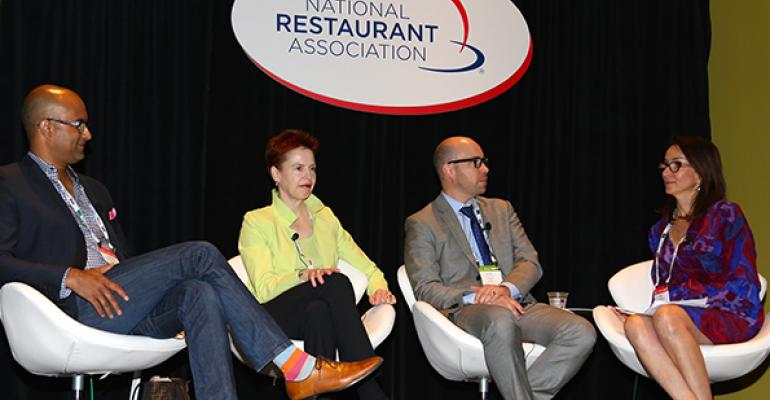Business diners spend significantly more than typical diners, and remain a lucrative source of revenue for restaurants, but the audience is changing as Millennials join the group, experts said Monday.
Business diners spend as much as 1.6 to 1.8 times as much as a typical diner, Santosh Jayaram, co-founder of Table8, an online restaurant reservation service, said during an NRA Show panel titled “Setting the Table for the New Business Diner.”
The panel was moderated by Mary Wagstaff, founder of Wagstaff Worldwide, a public relations and marketing firm, and included Peter Frost of Crain’s Chicago Business and Ti Martin of the restaurants Commander’s Palace, Café Adelaide and Sobou in New Orleans.
“We are very ‘old school,’” Martin said. “We have business people who are looking for that great dinner. We always try to have things they are comfortable with. My mom used to say, ‘You have to have a hunk of meat on the menu.’ She would call it ‘The Traveling Salesman.’”
Martin said her restaurants try to balance those “Traveling Salesman” menu stalwarts with more exciting items.
“You have to make the menu broad enough so someone doesn’t rule your restaurant out,” she said.
Jayaram noted that his research has found that 80 percent of business diners arrive at their destination with less than 10 days notice, make decisions at the last minute, and “travel in big packs.”
Restaurants could benefit from having modular architecture, which would provide areas for private dining, Jayaram said.
Martin also said her restaurants have tables that can accommodate larger parties, but with groups of more than 14 people, she has found that setting a special menu is required to maintain quality, “which helps people control the size of the check as well.”
Another way to build use by business diners is to have restaurants develop a “deep relationship” with corporations within a 10-block area and cultivate those links with complimentary desserts, emails for special events and seats set aside for those customers.
“You find ways to make access,” Jayaram said.
Restaurants are also adding larger tables where possible, Frost said, which appeal to younger Millennial business diners and their proclivity for gathering and sharing. Martin said her restaurant group recently added such a large table.
Technological systems help maintain customer relationships, Martin added, “but the people in the restaurants make the guest feel like a big shot.”
For example, Martin gives her best customers a “key to the backdoor,” which is an actual working key, but has a larger concept behind it, she said.
The gesture makes the best customers know how valued they are to the business.
“Those things go a long, long way to building business dining,” she said.
Contact Ron Ruggless at [email protected].
Follow him on Twitter: @RonRuggless

